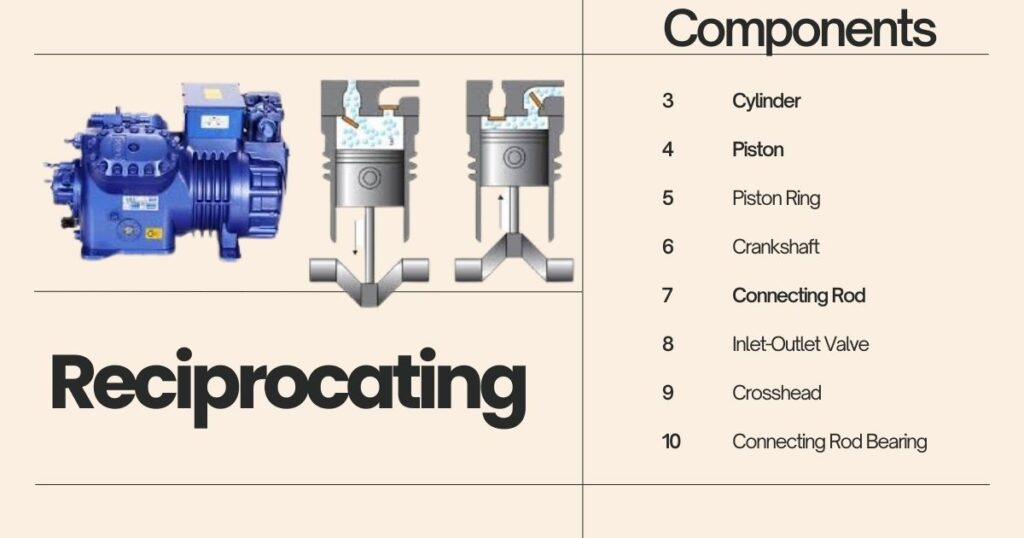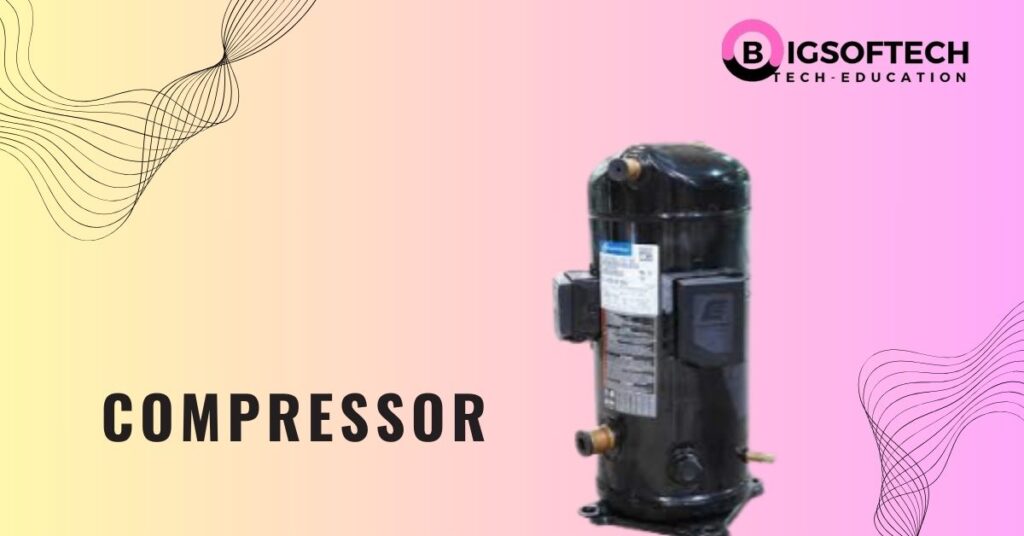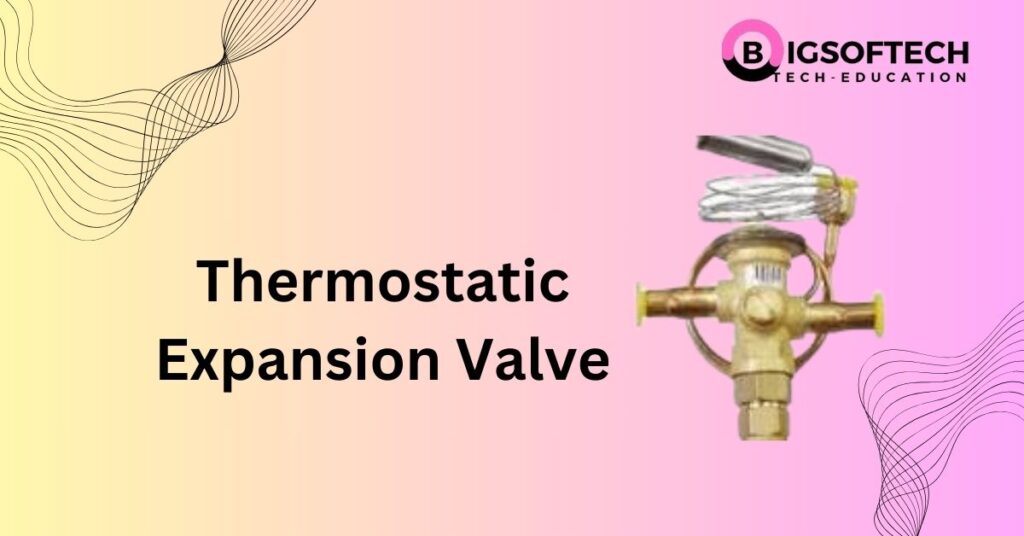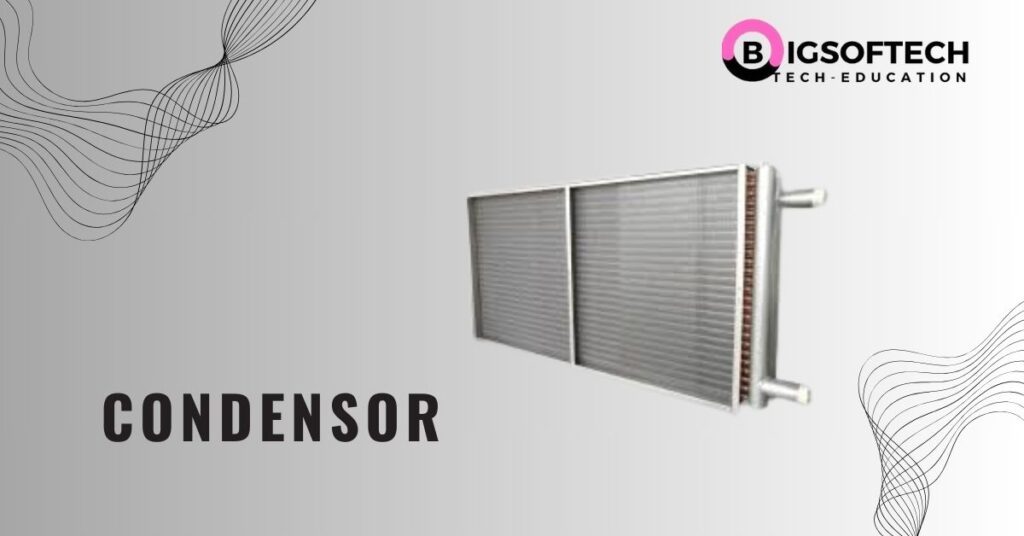What is a Reciprocating Compressor?
A reciprocating compressor is a type of positive displacement compressor that uses a piston to compress gas. Widely used in various industries, this type of compressor is known for its efficiency and reliability in applications that require high pressure. This article explores the working principles, advantages, applications, and maintenance tips for reciprocating compressors, helping you understand their role in HVAC systems and beyond.
Technical Specifications (Reciprocating Compressor)
| Parameter | Typical Range / Value |
|---|---|
| Type | Hermetic / Semi-Hermetic / Open-Type |
| Configuration | Single-Stage / Two-Stage |
| Cooling Capacity | 0.5 TR to 100+ TR (Tons of Refrigeration) |
| Refrigerants Used | R-22, R-134a, R-404A, R-410A, R-717 (Ammonia), R-290 (Propane) |
| Operating Speed | 1450–2900 RPM |
| Compression Ratio | 3:1 to 12:1 (depending on application) |
| Discharge Pressure | Up to 25 bar (362 psi) |
| Suction Pressure | Typically 2–5 bar (30–70 psi) |
| Power Consumption | 1 kW to 100+ kW |
| Lubrication | Splash / Forced (oil pump) |
| Volumetric Efficiency | 70–85% |
⚙️ Main Components
Cylinder and Piston
Crankshaft and Connecting Rod
Inlet & Outlet Valves
Electric Motor (in Hermetic units)
Suction & Discharge Ports
Lubrication System
📘 Formula:
Displacement=π4×D2×L×N×K\text{Displacement} = \frac{\pi}{4} \times D^2 \times L \times N \times K
DD = Diameter of the piston (in meters)
LL = Stroke length (how far the piston moves, in meters)
NN = Rotations per minute (RPM)
KK = Number of cylinders
Example:
Piston Diameter = 0.08 m (8 cm)
Stroke Length = 0.06 m (6 cm)
Speed = 1450 RPM
Number of Cylinders = 2
= 0.005026×0.06×1450×2≈0.873 m³/min= 0.005026 \times 0.06 \times 1450 \times 2 \approx 0.873 \, \text{m³/min}
So, the compressor moves about 0.87 cubic meters of gas per minute.
So, the compressor moves about 0.87 cubic meters of gas per minute
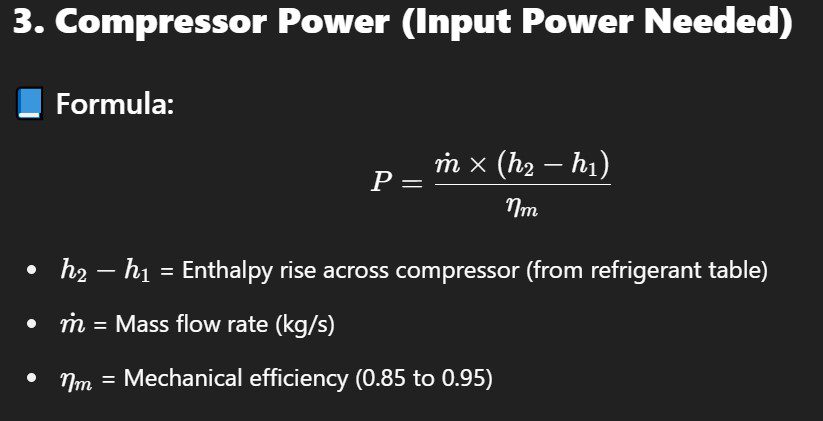

COP – Calculation
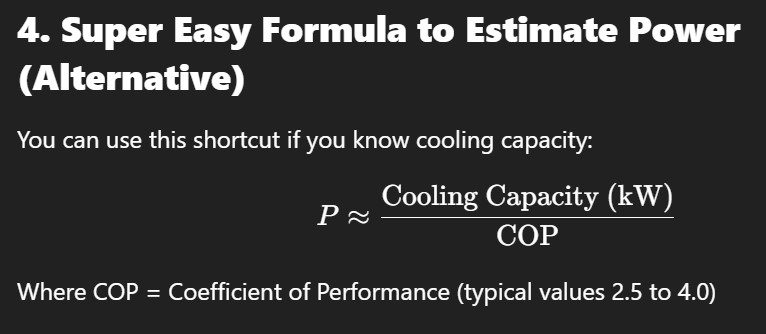

How Does a Reciprocating Compressor Work?
The primary working principle of a reciprocating compressor involves a piston moving inside a cylinder. As the piston moves down, it creates a vacuum that draws gas into the cylinder. When the piston moves up, it compresses the gas, increasing its pressure before it is discharged. This process is repeated in cycles, making the reciprocating compressor highly efficient for high-pressure applications.
Advantages of Reciprocating Compressors in HVAC Systems
Reciprocating compressors offer several advantages, especially in HVAC systems:
- High Efficiency: These compressors are capable of achieving high pressures, making them ideal for air conditioning and refrigeration systems.
- Reliability: Their robust design ensures long-term reliability, even under demanding conditions.
- Versatility: Reciprocating compressors can handle a variety of gases, making them suitable for multiple applications.
Reciprocating Compressor vs. Rotary Compressor
| Parameter | Reciprocating Compressor | Rotary Compressor |
|---|---|---|
| Working Principle | Positive displacement using piston-cylinder mechanism | Positive displacement using rotating elements (roller/scroll/vanes) |
| Compression Mechanism | Back-and-forth (reciprocating) motion of piston | Continuous rotary motion of compression element |
| Components | Cylinder, piston, crankshaft, valves, connecting rod | Rotor, stator, vane (in rotary vane), or scroll plates (in scroll type) |
| Refrigerant Flow | Intermittent (pulsating discharge) | Continuous and smoother discharge |
| Compression Cycle | Discrete strokes: suction → compression → discharge → return | Continuous suction and compression cycle |
| Efficiency (Volumetric) | 70–85% | 80–95% |
| Compression Ratio | High (up to 12:1 or more) | Moderate (typically up to 8:1) |
| Noise and Vibration | High due to reciprocating parts | Low due to smooth rotary motion |
| Maintenance Requirement | Higher – more moving parts, valves prone to wear | Lower – fewer moving parts |
| Lubrication System | Splash or forced lubrication | Oil circulation or oil-free (in some scroll/twin rotary types) |
| Cooling Capacity Range | 0.5 TR to 100+ TR (Tons of Refrigeration) | 0.5 TR to ~20 TR (mostly used in smaller to medium units) |
| Application Areas | Domestic refrigerators, industrial chillers, cold rooms, deep freezers | Residential and commercial ACs, refrigerators, VRF/VRV systems |
| Starting Torque | High | Low to Medium (may require soft starter or inverter) |
| Cost | Generally lower initial cost | Higher cost, but more compact and efficient |
| Size & Weight | Bulkier and heavier | Compact and lightweight |
| Durability | Rugged and robust for harsh conditions | Designed for continuous, clean operation |
| Part Load Performance | Less efficient at part load | More efficient, especially with inverter control |
| Example Types | Hermetic, semi-hermetic, open-type | Rotary vane, scroll, twin rotary, screw (larger systems |
When comparing reciprocating compressors to rotary compressors, several factors come into play:
- Pressure Capability: Reciprocating compressors are better suited for high-pressure applications, whereas rotary compressors are more efficient at low to moderate pressures.
- Maintenance: Reciprocating compressors generally require more maintenance due to the moving parts, but they offer superior performance in certain applications.
- Cost: While reciprocating compressors may have a higher upfront cost, their long-term efficiency can lead to cost savings.
Applications of Reciprocating Compressors in Industry
Reciprocating compressors are used in a wide range of industries:
- Petrochemical Industry: For compressing natural gas and other gases.
- Manufacturing: To power pneumatic tools and equipment.
- HVAC Systems: For air conditioning and refrigeration applications.
- Automotive Industry: In vehicle air conditioning systems.
Reciprocating Compressor Maintenance Tips
Proper maintenance of reciprocating compressors is crucial for ensuring their longevity and efficiency. Here are some key maintenance tips:
1. Routine Inspection & Cleaning
- Check for dirt, oil, and debris around the compressor.
- Clean fins, suction lines, and cooling fans regularly.
- Ensure ventilation around the unit to avoid overheating.
2. Check Lubrication System
- Monitor oil level and oil quality in the crankcase.
- Use manufacturer-recommended lubricants (viscosity and type).
- Replace oil at regular intervals or based on running hours.
- Clean or replace the oil filter (if equipped) to ensure proper flow.
3. Inspect Valves & Gaskets
- Check suction and discharge valves for wear, pitting, or leakage.
- Faulty valves can reduce compression efficiency.
- Replace gaskets or seals if oil/refrigerant leaks are found.
4. Check for Refrigerant Leaks
- Use electronic leak detectors or soap solution to check joints, flanges, and fittings.
- Leaks cause loss of cooling, overheating, and compressor damage.
5. Monitor Discharge & Suction Pressures
- Log suction pressure, discharge pressure, and superheat.
- Abnormal readings may indicate valve issues, refrigerant undercharge, or blocked filters.
6. Inspect Electrical Connections
- Check for loose terminals, burnt contacts, or damaged wiring.
- Ensure the motor is receiving the correct voltage and current.
- Perform megger testing for insulation resistance periodically.
7. Vibration & Noise Monitoring
- Excessive vibration can indicate misalignment, bearing wear, or valve problems.
- Use a vibration analyzer or manual inspection to detect unusual sounds or knocks.
8. Check & Maintain Pressure Relief Valves
- Ensure safety valves are not blocked and set to the correct pressure.
- Test valves annually to avoid overpressure hazards.
9. Crankshaft & Bearing Check (during overhaul)
- Inspect crankshaft journals, connecting rods, and bearings for scoring or wear.
- Replace worn bearings to avoid seizure or imbalance.
10. Follow Manufacturer’s Maintenance Schedule
- Refer to the OEM manual for service intervals.
- Schedule minor servicing (oil top-up, cleaning) monthly.
- Plan major overhauls (valve service, bearing inspection) annually or after specified run hours.
Reciprocating Compressor Efficiency Improvement Methods
Improving the efficiency of a reciprocating compressor can lead to significant energy savings. Some methods include:
Maintain Proper Superheat & Refrigerant Charge
- Ensure correct refrigerant charge level to avoid underfeeding or overfeeding.
- Maintain recommended superheat (typically 5–8°C).
- Use Thermostatic Expansion Valve (TXV) or Electronic Expansion Valve (EEV) for precise control.
📌 Benefit: Prevents liquid slugging and ensures optimal refrigerant vaporization before compression


How to Improve:
- Minimize clearance volume (space between piston and cylinder head).
- Use multi-stage compression for high-pressure ratios.
- Maintain valves and gaskets to prevent backflow or leakage.
- Keep suction gas temperature low for higher refrigerant density.
1. Use Intercooling for Multi-Stage Compressors
- In two-stage compressors, install an intercooler between stages to reduce refrigerant temperature before entering the second stage.
📌 Benefit: Reduces work of compression and improves thermodynamic efficiency.
2. Upgrade to High-Efficiency Motors
- Replace standard motors with IE3 or IE4 energy-efficient motors.
- Use Variable Frequency Drives (VFDs) to match compressor speed with load demand.
📌 Benefit: Reduced energy consumption under part-load conditions.
3. Optimize Suction Conditions
- Ensure low-pressure drop in the suction line (large diameter, minimal bends).
- Keep suction filters clean.
- Use liquid–suction heat exchanger for subcooling the liquid and cooling suction gas.
📌 Benefit: Improves refrigerant density and mass flow rate at constant volume.
4. Proper Lubrication Management
- Use low-viscosity synthetic oils designed for compressors.
- Regularly monitor and replace oil as per schedule.
- Install oil separators to return oil from discharge line to crankcase.
📌 Benefit: Reduces internal friction and extends component life.
5. Maintain Clean Heat Exchangers (Evaporator/Condenser)
- Clean evaporator coils and condenser fins regularly.
- Remove scale, dust, or debris that restricts heat exchange.
📌 Benefit: Reduces compressor head pressure and power consumption.
6. Check and Replace Worn-Out Components
- Replace worn valves, piston rings, and cylinder liners.
- Monitor vibration and bearing noise for early detection of wear.
📌 Benefit: Ensures optimal compression and prevents leakage losses.
7. Use Economizer (for Large Compressors)
- Install an economizer circuit for intermediate pressure flash gas injection.
- Improves cooling capacity and reduces compression work.
8. Implement Preventive Maintenance Plan
- Regular checks of:
- Suction/discharge pressure
- Oil level and temperature
- Electrical load (current)
- Superheat and subcooling values
📌 Benefit: Prevents breakdowns, ensures efficient operation continuously.
Common Issues with Reciprocating Compressors and Solutions
Despite their reliability, reciprocating compressors can encounter several issues:
- Valve Failure: Caused by wear and tear, leading to reduced efficiency. Solution: Regularly inspect and replace valves as needed.
- Overheating: Can occur due to insufficient lubrication or a malfunctioning cooling system. Solution: Ensure proper lubrication and check the cooling system regularly.
- Leakages: Air or gas leaks can reduce the compressor’s efficiency. Solution: Inspect and repair any leaks promptly.
Types of Reciprocating Compressors in Mechanical Engineering
Based on Number of Stages
Single-Stage Reciprocating Compressor
- Compresses air or gas in one stroke of the piston.
- Used for pressures up to 6–8 bar.
- Applications: Refrigerators, workshop air compressors, small pneumatic tools.
Multi-Stage Reciprocating Compressor
- Compresses gas in multiple stages (2-stage, 3-stage, etc.).
- Intermediate cooling (intercoolers) is used between stages.
- Used for high pressures up to 300 bar or more.
- Applications: Industrial refrigeration, gas plants, PET bottle manufacturing.
2. Based on Cylinder Arrangement
Horizontal Compressor
- Cylinders arranged horizontally.
- Easier maintenance and commonly used for stationary compressors.
Vertical Compressor
- Cylinders arranged vertically.
- Compact design, used in portable or mobile units.
V-Type Compressor
- Cylinders arranged in a “V” shape.
- Compact and well-balanced; common in medium to high-capacity systems.
Opposed Piston Compressor
- Pistons move towards each other in opposite directions.
- Highly balanced and used in heavy-duty industrial applications.
3. Based on Drive Type
Direct-Driven Compressor
- Crankshaft is directly coupled to the motor.
- Compact but less flexible in speed control.
Belt-Driven Compressor
- Motor drives the crankshaft via belts and pulleys.
- Allows speed adjustment, easier to maintain.
4. Based on Enclosure Type
Open-Type Compressor
- Crankshaft protrudes outside the casing.
- Requires external motor; easy maintenance.
- Used in: Large-scale refrigeration and industrial gas systems.
Hermetically Sealed Compressor
- Motor and compressor enclosed in a welded casing.
- Compact and quiet, but not serviceable.
- Used in: Household refrigerators, split AC units.
Semi-Hermetic Compressor
- Enclosed but can be opened for repair.
- Offers balance between serviceability and compactness.
- Used in: Commercial chillers, packaged units.
5. Based on Cooling Method
Air-Cooled Compressor
- Uses ambient air for cooling cylinder and motor.
- Simpler and cost-effective, suitable for low-duty applications.
Water-Cooled Compressor
- Uses water jacket around cylinders.
- More efficient cooling for heavy-duty and high-pressure operations.
6. Based on Operating Mode
Single-Acting Compressor
- Compression occurs only on one side of the piston per cycle.
- Simpler and more common in small capacity compressors.
Double-Acting Compressor
- Compression occurs on both sides of the piston per cycle.
- Higher efficiency and capacity, used in industrial applications
Best Practices for Operating a Reciprocating Compressor
To ensure optimal performance of a reciprocating compressor, follow these best practices:
- Operate Within Recommended Limits: Always operate the compressor within the manufacturer’s recommended pressure and temperature limits.
- Regular Maintenance: Adhere to a strict maintenance schedule to prevent breakdowns and extend the compressor’s lifespan.
- Training for Operators: Ensure that all operators are properly trained in the use and maintenance of the compressor.
Energy Consumption of Reciprocating Compressors in Factories
Energy consumption is a critical factor in the operation of reciprocating compressors, especially in industrial settings. While these compressors are efficient, they can consume a significant amount of energy, especially if not properly maintained. Implementing energy-saving measures, such as regular maintenance, upgrading components, and using VSDs, can significantly reduce energy consumption.
Conclusion
Reciprocating compressors are essential components in various industries, offering high efficiency, reliability, and versatility. By understanding how these compressors work, their advantages, and how to maintain them, you can ensure optimal performance and longevity. Whether you’re using a reciprocating compressor in an HVAC system or an industrial application, following the best practices outlined in this article will help you get the most out of your equipment.

